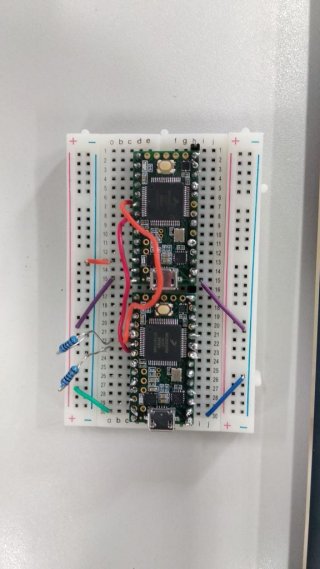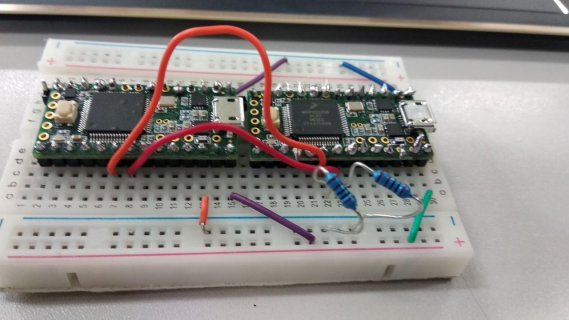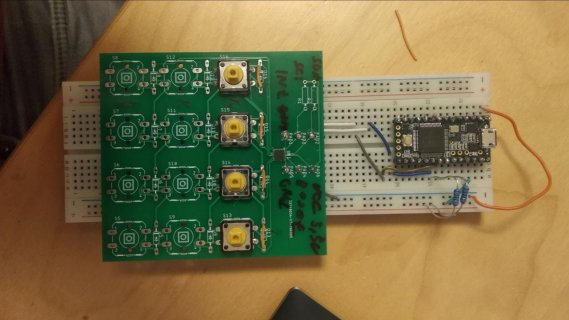You are using an out of date browser. It may not display this or other websites correctly.
You should upgrade or use an alternative browser.
You should upgrade or use an alternative browser.
I2C problem
- Thread starter MistrKernnunos
- Start date
- Status
- Not open for further replies.
PaulStoffregen
Well-known member
This may be a little late to save those boards, but maybe it'll help?
PaulStoffregen
Well-known member
To move forward on this, I'd suggest putting an LED on each of those 4 pins and try running the LED blink example. That can help you figure out if the pins really are connected.
If you do find 1 or more pins need to be re-soldered, here's a couple ideas that might help...
Solder has a chemical added called "flux". It's essential to getting good results. A common novice mistake looks like applying the solder to your iron, then with a ball of molten solder hanging off the tip of the iron, touching it to the pad and pin to be soldered. All the flux chemical ends up only on your iron, where it can't have the cleaning & whetting action on the pad & pin.
Put the tip of your iron onto the existing solder and let it get fully molten. Then apply a little more solder, hopefully touching or coming as close as practical to the pad. This will add more solder, which isn't really what you want... the thing you *really* need is some of the flux chemical to get into the molten mix. It will really help the new and old solder to flow.
Always leave the iron in contact for at least half a second after you withdraw the solder. Letting all 3 metals (the solder, the pin, and the pad) fully heat to the same temperature is important. Then they all cool together. That's essential for forming a good bond between the metals.
If you do find 1 or more pins need to be re-soldered, here's a couple ideas that might help...
Solder has a chemical added called "flux". It's essential to getting good results. A common novice mistake looks like applying the solder to your iron, then with a ball of molten solder hanging off the tip of the iron, touching it to the pad and pin to be soldered. All the flux chemical ends up only on your iron, where it can't have the cleaning & whetting action on the pad & pin.
Put the tip of your iron onto the existing solder and let it get fully molten. Then apply a little more solder, hopefully touching or coming as close as practical to the pad. This will add more solder, which isn't really what you want... the thing you *really* need is some of the flux chemical to get into the molten mix. It will really help the new and old solder to flow.
Always leave the iron in contact for at least half a second after you withdraw the solder. Letting all 3 metals (the solder, the pin, and the pad) fully heat to the same temperature is important. Then they all cool together. That's essential for forming a good bond between the metals.
MistrKernnunos
Member
Thanks for the ideas, the connection between the pins and teensy is good. The program suddenly started working I dont know what I have done, but now it works.
However I have another problem. I am playing with TCA 8418. But as soon as I try to end transmission the program wont contiunue.
This is the output of the code
setup begin
setup
setup
setup
I dont know what to do, and I sadly dont have osciloscope
However I have another problem. I am playing with TCA 8418. But as soon as I try to end transmission the program wont contiunue.
Code:
#include <Wire.h>
#include <WireKinetis.h>
#define adress 0x34
void setup() {
Serial.begin(9600);
Serial.println("setup begin");
Wire.beginTransmission(adress);
Serial.println("setup");
Wire.write(0x01);
Serial.println("setup");
Wire.write(0xFF); //initial setup of the chip
Serial.println("setup");
Wire.endTransmission();
Serial.println("setup");
Wire.beginTransmission(adress);
Wire.write(0x1E);
Wire.write(00000001); // set row 1
Wire.endTransmission();
Serial.println("setup");
Wire.beginTransmission(adress);
Wire.write(0x1E);
Wire.write(00001111); //set colum 1-4
Wire.endTransmission();
Serial.println("setup done");
}
byte REG;
void loop() {
Wire.beginTransmission(adress);
Wire.write(0x04);
Wire.endTransmission();
Wire.requestFrom(adress, 1); // request 1 byte(s) from slave device.
while(Wire.available()) // slave may send less than requested.
{
REG = Wire.read();
Serial.println(REG);
}
}This is the output of the code
setup begin
setup
setup
setup
I dont know what to do, and I sadly dont have osciloscope
Do yourself a favour and solder it better... it works now, but you can't be sure it still works in a hour, a week or a month.The program suddenly started working I dont know what I have done, but now it works.
https://www.arduino.cc/en/Reference/WireEndTransmission
endTransmission gives you a returncode - have you tried to print it?
endTransmission gives you a returncode - have you tried to print it?
PaulStoffregen
Well-known member
but you can't be sure it still works in a hour, a week or a month.
Or when the temperature changes, causing slight thermal expansion of the material.
MistrKernnunos
Member
Hi, I resoldered the pins. Teensy can find the chip and start a transmission, but it hangs when I end the transmission. Do you have any ideas what icould caus the hang?
PaulStoffregen
Well-known member
Do you have any ideas what icould caus the hang?
Could be a hardware issue, like one or both pins stuck low.
Could be something wrong on the software side.
Since we can't see your new hardware connection, and we don't know what you're doing for the code, how could anyone help? You need to show us what you're doing, ideally with enough info that anyone could reproduce the problem if they have the right hardware.
MistrKernnunos
Member
MistrKernnunos
Member
Yes, it finds the chip
PaulStoffregen
Well-known member
Your code in msg #5 is missing Wire.begin().
Open any of the Wire library examples to see how it should be done.
Open any of the Wire library examples to see how it should be done.
MistrKernnunos
Member
Thanks for the advice. Now it is not hanging on the endTransmission, but it is returning 2 and that means NACK on adress, but I am sure that the adress is right.
PaulStoffregen
Well-known member
Maybe run that scanner example again? It's the easiest way to check the address.
MistrKernnunos
Member
Thanks for the advices. Now it is working well, bur I have different problem. the problem is that whenever I press a button that is in the key matrix the chip wont respond to any messeges. the wire.endTransmission returns 2.
Code:
#include <Wire.h>
#include <WireKinetis.h>
#include "Wire.h"
#define adress 0x34
#define row 0x07
#define col 0x0F
void setup() {
pinMode(11, INPUT_PULLUP);
pinMode(13, OUTPUT);
Serial.begin(9600);
delay(1000);
Serial.println("setup begin");
Wire.begin();
Wire.beginTransmission(0x34);
Serial.println("setup");
Wire.write(0x01);
Serial.println("setup");
Wire.write(0x01); //initial setup of the chip
Serial.println("setup");
int n = Wire.endTransmission();
Serial.println(n);
Serial.println("setup");
Wire.beginTransmission(adress);
Wire.write(0x1D);
Wire.write(row); // set row 1
n = Wire.endTransmission();
Serial.println(n);
Serial.println("setup");
Wire.beginTransmission(adress);
Wire.write(0x1E);
Wire.write(col); //set colum 1-4
n = Wire.endTransmission();
Wire.beginTransmission(adress);
Wire.write(0x29);
Wire.write(row); // set debounce for row 1
n = Wire.endTransmission();
Serial.println(n);
Wire.beginTransmission(adress);
Wire.write(0x2A);
Wire.write(col); // set row 1
n = Wire.endTransmission();
Serial.println(n);
Serial.println("setup done");
Serial.println(n);
}
byte REG;
void loop() {
int INTERUPPT = digitalRead(11);
if(INTERUPPT == LOW)
{
digitalWrite(13, HIGH);
}
delay(1000);
Wire.beginTransmission(0x34);
Wire.write(0x1E);
Serial.print("prenos: ");
int m = Wire.endTransmission();
Serial.println(m);
Wire.requestFrom(0x34, 1); // request 1 byte(s) from slave device.
while(Wire.available()) // slave may send less than requested.
{
REG = Wire.read();
Serial.print("reg: ");
Serial.println(REG);
}
// delay(1000);
}- Status
- Not open for further replies.




